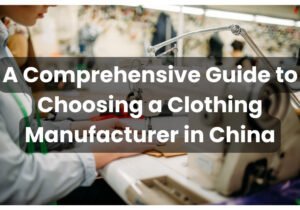What is fast fashion?

The term “fast fashion” originated in Europe in the 20th century and was called “Fast Fashion”, while in the United States it was called “Speed to Market”, which is short for “fast and fashion “. Fashion design responds quickly to trending products. Its characteristics of fast delivery time, affordable price and keeping up with the trend have greatly stimulated the interest of consumers.
Fast fashion is a term used to describe a highly profitable business model based on copying the trends and models and make low-cost mass production. According to the EAC (Environmental Audit Committee), fast fashion is defined as “an accelerated fashion business model” that involves “an annual increase in the number of new fashion collections”, “fast turnover” and “lower prices”.
The evolution of fast fashion
1. Origin
Before the industrial revolution, clothes were made to order, often weeks or even months in advance. After the industrial revolution, the textile and manufacturing industries developed rapidly. Historically the slave trade, cotton was grown in large quantities in the southern United States and exported to England.
Long-standing unequal trading conditions between developed and developing countries have made clothing cheaper to produce in low-cost regions like Asia. Production has shifted from China to low-cost centers including Vietnam and Bangladesh. The concept of fast fashion is based on the 1980s apparel manufacturing model known as “quick response” in the United States.
In the 1990s, the United States began competing in the market by developing low-cost fashion clothing such as large department store chains. But real fashion retailers are under enormous pressure. So retailers divide the supply chain:basic models can be produced in the Far East, for example, Asia and Africa, while popular models can be made closer to home in Europe or South America.
In 2000, the price of European clothing fell by 26.2%. When the price falls, the demand increases and the bad habit of consuming clothes arises, fast fashion clothing begins to develop rapidly.
In 2006, people bought 30% more clothes than in 2002. This has intensified competition between fashion brands such as H&M, Zara, Topshop and Gap, which have started to launch more clothing collections to meet the demand of the fashionable clothing consumers, greater variety and limited edition clothing.
Today there are more than 80 billions clothing consume every year, an increase of almost 400% compared to 30 years ago.
2. The creator of fast fashion: ZARA
The Spanish Zara is almost synonymous with fast fashion. Other big names in fast fashion include H&M in Sweden, Uniqlo in Japan, GAP and Forever 21 in the US and Topshop in the UK.
ZARA, founded in Spain in 1975, belongs to the Inditex Group and ranks third in the world and first in Spain. ZARA has more than 6,500 stores in 88 countries around the world. When it comes to fast fashion, Zara is a well-deserved creator.
Speaking of the family history of Zara, we have to mention the discreet billionaire founder of ZARA, Amancio Ortega. Ortega, who was born in poverty, worked in a tailor’s shop when he was young and later found that expensive nightgowns often drove customers away, so he and his wife came up with the idea of making cheap and high quality stylish nightgowns and sell them to customers. The product was hugely successful as soon as it was released. Ortega, who had tasted the sweetness, immediately opened a factory with his wife. But the good times did not last long. When he was 40, Ortega was almost on the verge of bankruptcy due to the cancellation of the order by an important German customer. So Ortega cut off all means of retreat and founded a self-made, self-selling branded company called Zara.
In 1975, Amancio Ortega opened a small clothing store called Zara in La Coruña that spent 5,000 pesetas (the Spanish currency, equal to 30 euros).
This will be Zara’s first step towards the top of the apparel retail sector!
After 5 years of hard work, Zara was recognized by the Spanish market for its low price and trend, so Zara decided to attack the European market in 1990. It successfully opened 500 Zara stores in 9 European countries. And in 2000, its tentacles spreaded to North America.
Zara has its own sales strategy, it will open stores in the prosperous areas of the city and slowly spread its tentacles to the smaller surrounding towns. It just like a large drop and then slowly spreading out.
Soon, in 2006, Zara became a household name in Asia.
Now Ortega has opened Zara all over the world. There are 88 countries where Zara is stationed and there are 7,000 stores worldwide. Ortega, who owns Zara, has overtaken Bernard Arnott, owner of the luxury brand LV,who let the brand trend feel the power of the masses.
Fast fashion feature
Save effort, large quantity and fast speed are the first principles.
Fast Fashion brings the current season’s fashion week designs to the store at the lowest production cost, so customers can quickly grasp the latest international fashion trends. Some fast fashion brands have up to 18 new collections per year.
An important difference between fast fashion retailers and non-fast fashion brands: the rapid growth of production. The basis of the fast fashion business model is to shorten the time period from production to consumption of customers, so that consumers can keep up with the fashion trend in the shortest possible time. Fast fashion brands attract traditional consumers at lower prices by optimizing their supply chains to design and produce trendy clothes quickly and profitably. Due to the low-cost mass-produced garments, the quality is comparatively poorer.
Who is fast fashion suitable for?
Although older people also like fast fashion, the people who consume the more fast fashion brands are under the age of 28. Millennial consumers, in particular, are more willing to embrace fast fashion.
Fast fashion brands tend to attract younger generations as they open stores based on runway trends and trend-loving young shoppers can wear the same high fashion clothes without breaking the bank. The fast fashion retailer’s target audience is mainly consumers aged 18-24, who are typically low-income students. Women in this age group shop at fast fashion stores more often than any other demographic.
How to create your own fast fashion style
Fast fashion updates very quickly, and brands are very good at hunger marketing. The speed of launching new products every week constantly attracts customers to visit the stores frequently, choosing a marketing method of less quantity and more models. A popular style will be sold out soon and won’t be replenished no matter how popular it is. Therefore, some consumers will buy the latest and hottest styles, whether they are really suitable for them or not and then will discard casually if don’t like. So how should we create a fast fashion style that suits us?
1. Don’t blindly follow the crowd, just choose what suits you
If you pay attention to the interviews of fashion masters in the field of wearing, the media will ask how they form their own style of wearing. Few people can summarize the same skills as formulas, because the style judged only by the looks does not necessarily conform to their own inner preferences and body shape. But we all agree on one point: the style of dressing is the embodiment of our inner character and lifestyle.
What’s the difference between fashion and style? There is a saying called “fashion is perishable, style is eternal.” Sounds like fashion and style are opposite? No, fashion is the collocation or item popular in a specific period, and style is a person’s self-expression through clothes. It’s actually very simple for ordinary people to apply it: choose what suits their style from the trendy items.
2. Have self aesthetic consciousness and thoughts
Only when a person’s external and internal unity can he make himself and others feel comfortable. Nowadays, the media and marketing are all using all kinds of continuous small consumption to amplify sensory stimulation and guide you to overdo in an all-round way. Whenever we surf the Internet and visit Shein, we will be dazzled by the dazzling array of model photos, star wearing and publicity. However, when you really want to place an order, please seriously ask yourself the following question: do I really need it? Does it really suit me? Is there a high probability that I will buy it and leave it idle?
3. Don’t frame yourself easily
Generally speaking, a person’s wearing style has six preference types: classic, fashionable, exaggerated, natural, romantic, creative, urban and ethnic. But people’s preferences are complex. A person’s clothing may combine two or three of them. For example, the French style we often say is not all the same. Some tend to be classic, and some tend to be romantic. We may like two or three styles of clothes at the same time. As long as the whole looks have show advantage, we can gradually try some mixing and matching.
4. Record the days when “I’m the best”
There are always days when you think you look really good, and you can’t help looking in the mirror. This is often the best time when external clothes and internal preferences blend together. Remember to take a picture and record it, which will be of great reference significance in the future.
The pros and cons of fast fashion
In fact, the fast fashion business model is based on consumers’ desire for fashionable clothes. The price of fast fashion items is usually much lower than the competition (especially high-end luxury brands) and the essence is: low-quality + high-volume business model operation.
For fast fashion corporate brands: fast production of garments that are profitable and meet the changing needs of consumers. This is the biggest advantage of fast fashion and the fundamental reason why it can thrive.
But fast fashion also creates many obvious problems:
1. Misappropriation and copyright issues
In 2021, the impact of social media is enormous. It is clear that social networks reinforce the fast fashion model. In the past, fast fashion brands had to walk the runway or turn to print magazines and fashion spies to get their original work. Today, as fast fashion brands attract legions of celebrities to social platforms like Instagram, the copying process becomes instant. Designers begin the “theft” process as soon as the designer’s new and unique work reaches the social platform. Fast Fashion or Ultra-Fast Fashion: Fast fashion brands can find, collect and replicate a designer’s entire collection online in less than a week. More than 10,000 reproductions occurred in one week. Ship to multiple distributors or online platform warehouses within one week.
2. A lot of pollution and waste
A recent report specifically found that over 87% of instant brands purchase materials and labor from China, India, Pakistan and Turkey, which has a serious impact on the environment. Each year, 85% of all textiles produced in the world end up in landfills. Furthermore, judging by the survey of all the fast fashion giants, only Zara and H&M have established adequate recycling and waste management policies. But it doesn’t seem enough to stand up to scrutiny.
3. Slavery in times of peace
Low-cost manufacturing requires not only low-cost materials, but also low-cost labor. According to a Fashion Checker survey, 93% of fast fashion brands do not pay a living wage to their textile workers. To keep production costs low, fast fashion brands are constantly shifting production to developing countries where wages are lower.
4. Disposable Culture
To make the fast fashion business model thrive, brands spend as little time as possible developing products related to fashion trends and sell them at a price several times or even dozens of times lower than design brands to trigger impulsive purchase of people. As for the number of times consumers can buy and use it, it is beyond the consideration.
As the trend ends, these “low quality, low priced” products are discarded by consumers in what is known as a “throwaway culture”. According to The Guardian, two-thirds of women are the largest segment of fast fashion consumers, and clothes worn once or twice are considered obsolete.







